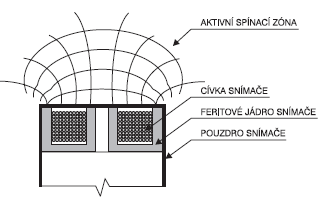Inductive position sensor for metallic materials and its application in practice
An inductive sensor is used to detect the presence of any metallic material. The sensor may be used as a terminal proximity switch on machines, automatic lines, etc. This sensor can be used in dusty as well as outdoor environment. The sensor is intended for the connection in direct-current circuits with the range of supply voltage 10-30 V (for selected types, 10-60 V), or alternating-current circuits with range 22-250 V or 180-250 V.
Function description
The sensor consists of an oscillator operating on the principle of change of the Q factor of the core when approaching any metallic material. This change is shown by oscillator vibration damping and the oscillator stops vibrating. Oscillator vibration damping is evaluated by a threshold detector operated by a flip-flop circuit controlling the power output stage. By removing the metallic material from active operating zone, the oscillator reestablishes vibrations. According to the type of the switch, closing or opening, the output is either closed or opened when approaching any metallic material to the active zone of the sensor.

Sensor diagram

Active operating zone